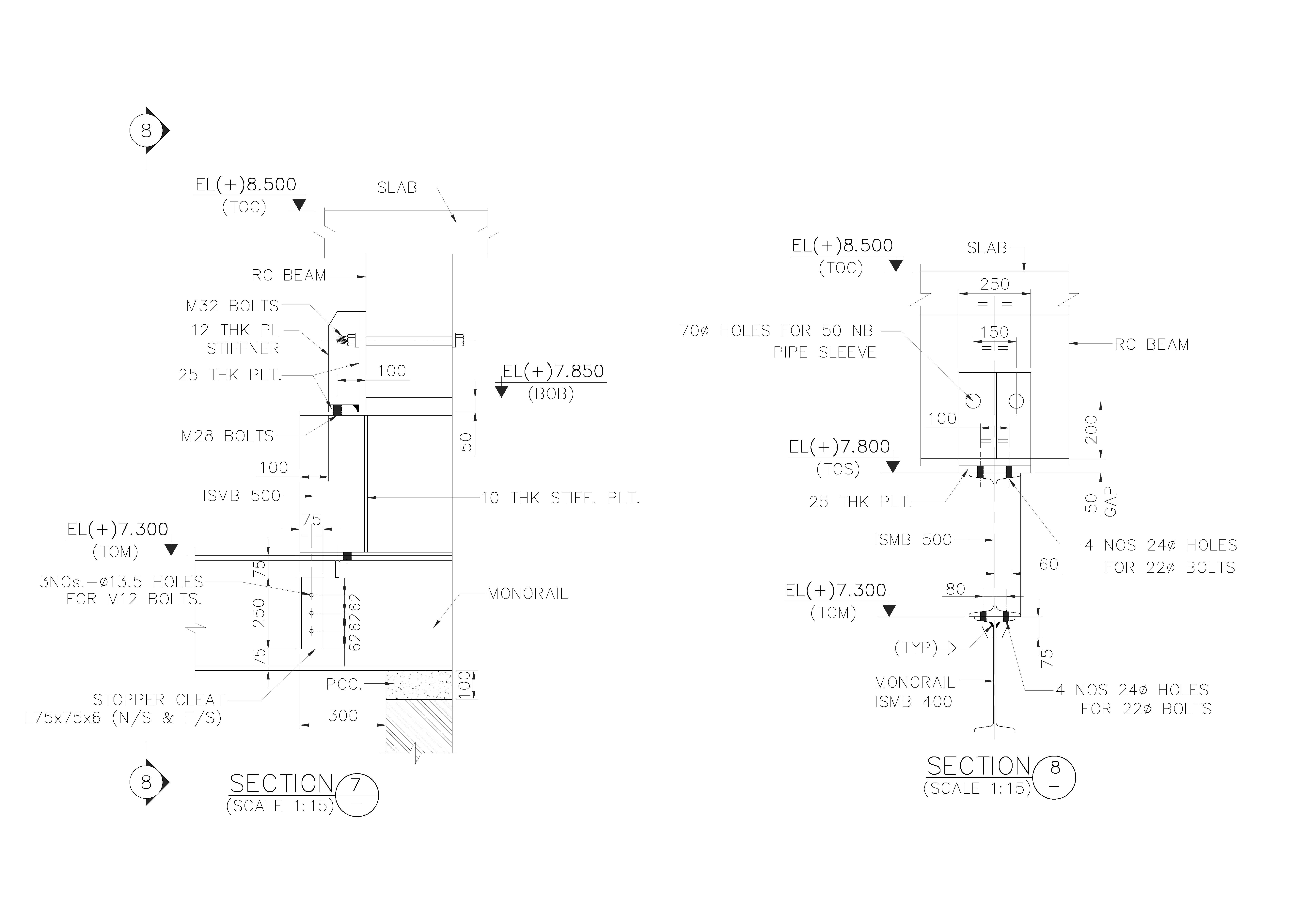To create a monorail drawing connected to a concrete beam, several basic concepts should be considered for both the structural integrity of the connection and the overall functionality of the monorail system. Here’s an outline of the basic concepts required for drawing a monorail on a concrete beam:
- Structural Elements of Monorail System:
- Monorail Beam (Track Beam): This is the main beam where the monorail vehicle will travel. The beam needs to be accurately detailed in terms of its size, material, and connection to the supporting concrete structure.
- Supporting Concrete Beam (Support Structure): The monorail track is supported by a concrete structure. This beam must be properly reinforced and designed to transfer loads from the monorail system.
- Anchorages and Fixings: The connection between the monorail track beam and the concrete support must be clearly illustrated, showing the anchor bolts, base plates, and any other structural fixings.
- Load Path and Transfer Mechanism:
- The drawing should reflect how vertical loads (dead and live) and horizontal forces (wind, seismic, braking) are transferred from the monorail track to the concrete beam.
- Load transfer diagrams should show:
- Vertical loads: These come from the weight of the monorail vehicle and passengers.
- Horizontal loads: Braking forces, wind loads, and lateral movements of the monorail need to be accounted for.
- Dynamic loads: Vibrations from the moving train should be managed with dampers or flexible connections.
- Reinforcement of Concrete Beam:
- The concrete beam must be reinforced adequately to handle both flexural (bending) forces and shear forces.
- Show the steel reinforcement in the concrete beam, particularly near the monorail connections.
- Indicate longitudinal bars, stirrups, and any additional reinforcement necessary near the supports or connections.
- Monorail Track to Concrete Beam Connection:
- The drawing should clearly indicate how the monorail track connects to the concrete beam. Common connection details include:
- Anchor bolts: Detail the size, number, and placement of anchor bolts that will secure the monorail track to the concrete beam.
- Base plates: Show steel base plates that spread the load from the monorail track to the concrete beam.
- Shear connectors: For horizontal load transfer, you may use shear studs or plates between the monorail and concrete beam.
- Neoprene pads or rubber bearings: Include details for vibration isolation pads to prevent direct transmission of vibration from the track to the concrete.

- Dimensional Details:
- Provide the dimensions for both the monorail beam and the concrete beam in the drawing.
- Beam depth and width are critical for ensuring the system can support the expected loads.
- Spacing of anchor bolts or spacing of supports needs to be specified.
- The clear height between the top of the concrete beam and the underside of the monorail should also be shown for clearance and installation purposes.
- Expansion Joints:
- Include expansion joints in the drawing for long spans of the monorail track to account for thermal expansion and contraction.
- The expansion joint details should indicate how the monorail track can move without stressing the concrete beam connection.
- Section and Elevation Views:
- Provide section views (cross-sections) to clearly show how the monorail beam sits on or connects to the concrete beam.
- Elevation views should illustrate the overall profile of the monorail structure in relation to the concrete beam, including height, width, and relative positions of the components.

- Tolerances and Clearances:
- Indicate any tolerances required in the construction, especially for the connections between steel (monorail track) and concrete (beam).
- Show clearance details for maintenance access or safety, ensuring there is enough space between the monorail and surrounding structures.
- Support Conditions:
- Specify whether the concrete beam is simply supported, fixed, or continuous. This affects the load distribution and the reinforcement detailing.
- Vibration and Fatigue Resistance:
- Monorails generate vibrations, so the drawing should indicate where dampers or flexible connections are installed to absorb these vibrations.
- The connections and concrete reinforcement should be designed to resist fatigue, especially in high-traffic areas where the monorail will be used frequently.

Categories
- 3D HOUSE DESIGN (19)
- Civil and Structural Design Calculations (41)
- Commercial Plans (9)
- East Facing House Plans (14)
- Engineering Concepts – Civil & Structural (155)
- Excel Spreadsheets (18)
- Free Downloads (17)
- House Plans (51)
- Industrial standards (69)
- North Facing House Plans (15)
- South Facing House Plans (12)
- West Facing House Plans (7)
Related Posts:

